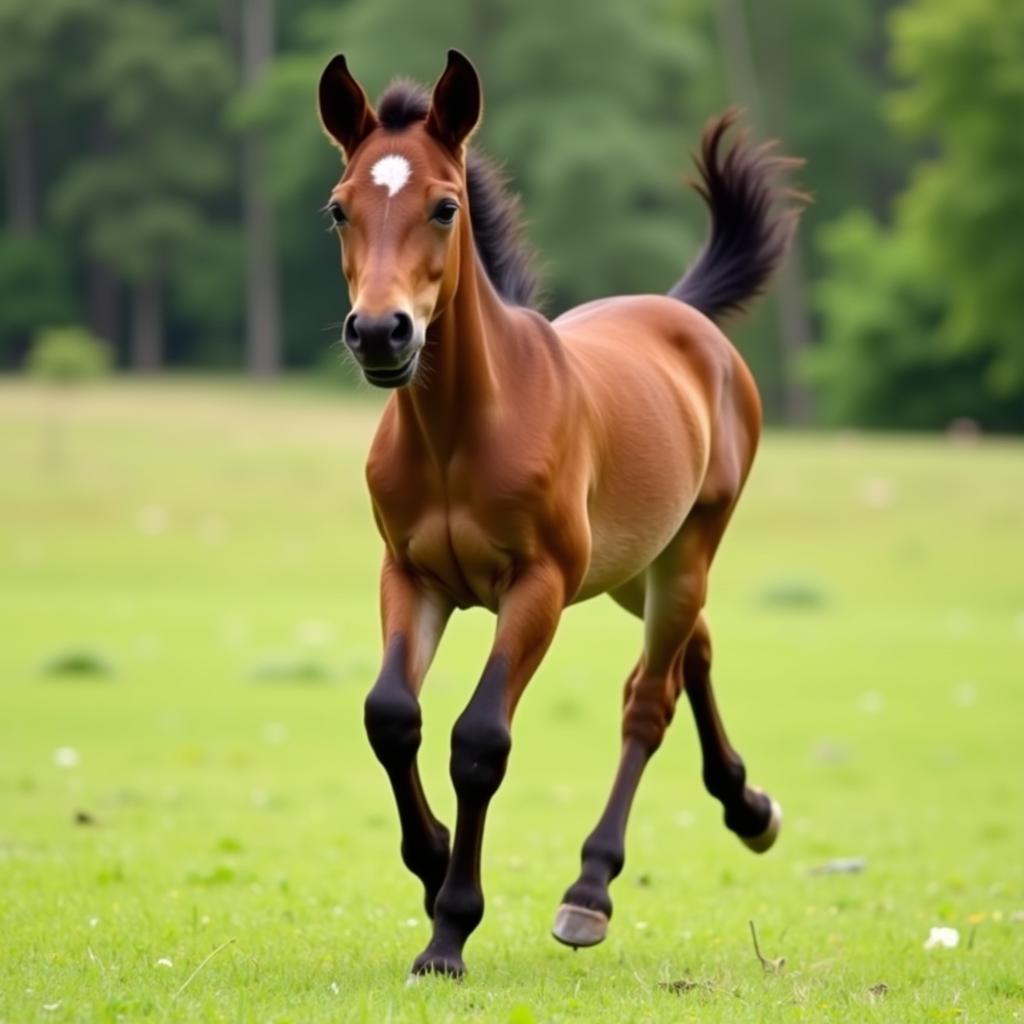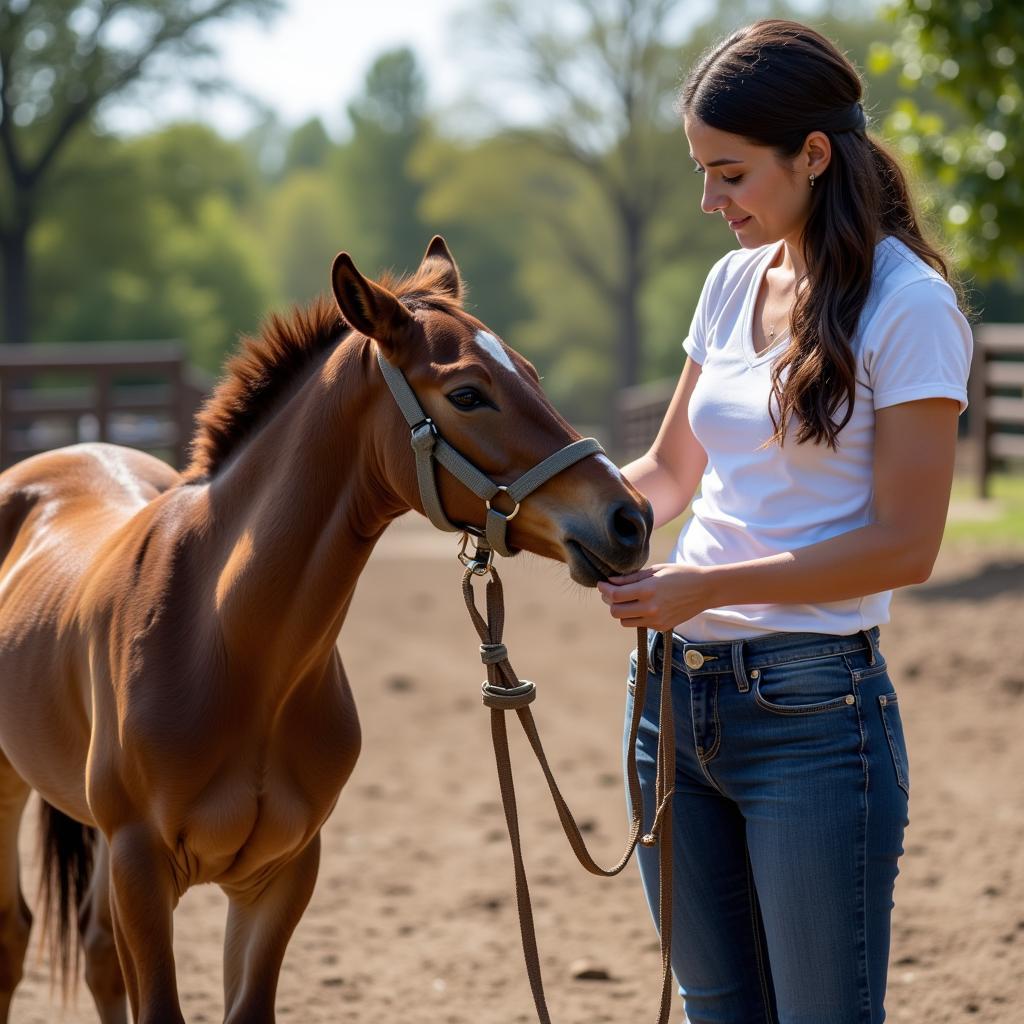Colt training is a rewarding but challenging journey that requires patience, consistency, and a deep understanding of equine behavior. This comprehensive guide will provide you with the knowledge and tools you need to successfully train your colt, setting him up for a lifetime of partnership and success.
Understanding Colt Behavior: The Foundation of Training
Before diving into specific training techniques, it’s crucial to understand the unique behavioral characteristics of colts. Colts are young male horses, typically under four years old, who haven’t been gelded (castrated). Their behavior is heavily influenced by surging testosterone levels, leading to:
- High Energy Levels: Colts are naturally playful and energetic, often exhibiting bursts of running and playing.
- Dominance Testing: As they mature, colts naturally test boundaries and establish dominance hierarchies.
- Sensitivity to New Experiences: Colts are learning and adapting to the world around them, making them potentially more reactive to unfamiliar sights, sounds, and sensations.
 Colt playing in a field
Colt playing in a field
Building Trust: The Cornerstone of Colt Training
Building a strong foundation of trust is paramount when training a colt. This involves:
- Positive Reinforcement: Use rewards-based training methods that focus on positive reinforcement, such as treats, scratches, and verbal praise, to motivate and encourage desired behaviors.
- Patience and Consistency: Colts learn at their own pace. Patience is key to avoiding frustration for both you and your colt. Consistent training routines and expectations will help him understand what’s expected of him.
- Clear Communication: Use clear and consistent cues, both verbal and physical, to communicate with your colt. Avoid confusing or mixed signals that can hinder his learning process.
Groundwork Essentials: Establishing Control and Respect
Groundwork forms the basis of all colt training, establishing control, respect, and responsiveness to your cues. Key groundwork exercises include:
- Haltering and Leading: Teach your colt to accept the halter calmly and respond to pressure, allowing you to lead him safely and confidently.
- Yielding to Pressure: Teach your colt to move away from pressure applied by your hands on his body, fostering respect for your personal space.
- Lunging: Introduce lunging exercises to teach your colt to move in circles around you, responding to your voice and body language cues.
 Halter training a colt
Halter training a colt
Introducing the Saddle and Rider: A Gradual and Positive Approach
Introducing the saddle and rider should be a gradual process, focusing on positive associations and desensitization. Start by:
- Saddle Pad Familiarization: Introduce the saddle pad first, placing it gently on the colt’s back and allowing him to become accustomed to its weight and feel.
- Saddling: Gradually introduce the saddle, starting with short periods of wearing it while being led.
- Ground Driving: Once the colt accepts the saddle comfortably, introduce ground driving to familiarize him with the feel of reins and pressure on the bit.
Starting Under Saddle: Patience and Experienced Guidance
Starting a colt under saddle is a significant milestone that requires patience, experience, and a calm demeanor. It’s highly recommended to seek guidance from a professional horse trainer during this stage. They can provide:
- Safe Handling Techniques: Ensure both your and the colt’s safety during the initial rides.
- Proper Riding Techniques: Teach you how to effectively communicate with the colt under saddle and develop his balance and coordination.
- Troubleshooting and Problem-Solving: Address any behavioral issues that may arise during the training process.
Common Colt Training Challenges and Solutions
Colt training often presents unique challenges due to their energetic nature and hormonal fluctuations. Here are some common issues and effective solutions:
- Nipping and Biting: Redirect nipping or biting attempts by using a firm voice command (“No!”) and immediately redirecting his attention to a more appropriate behavior.
- Kicking: Ensure you’re positioned safely and use a long whip to discourage kicking. Never punish a colt for kicking, as this can escalate the behavior.
- Bucking: Address bucking by remaining calm and maintaining control. Work on establishing a stronger foundation of basic obedience and trust.
Expert Insight
“Remember, training a colt is a partnership, not a battle of wills,” says renowned horse trainer, Sarah Williams. “Patience, consistency, and clear communication will be your greatest allies in this rewarding journey.”
Conclusion
Training A Colt Horse is a challenging yet incredibly rewarding endeavor. By understanding colt behavior, building a foundation of trust, and implementing effective training techniques, you can help your colt reach his full potential. Remember, patience, consistency, and clear communication are key to success. With dedication and the right approach, you and your colt can embark on a lifelong journey of partnership and shared success.
FAQs
1. When is the best time to start training a colt?
While there’s no set age, it’s generally recommended to start groundwork training as early as possible, ideally when the colt is a weanling (around six months old).
2. How long does it take to train a colt?
The training timeline varies depending on the colt’s temperament, breed, and your training goals. It’s a gradual process that can take months or even years to achieve specific levels of training.
3. Should I geld my colt?
Gelding a colt can help reduce hormonal behaviors and make him easier to handle. However, the decision to geld is personal and should be discussed with your veterinarian.
4. What are some signs of a well-trained colt?
A well-trained colt will be responsive to your cues, respectful of your personal space, and willing to learn new things. He’ll be a pleasure to handle both on the ground and under saddle.
5. Where can I find additional resources for colt training?
Reputable horse trainers, equine behaviorists, and online resources from organizations like the American Quarter Horse Association can provide valuable information and support.
Need More Help?
For personalized advice and support on training your colt, contact our team of experts at Justus Horses USA. Call us at 0772127271, email us at [email protected] or visit our location at QGM2+WX2, Vị Trung, Vị Thuỷ, Hậu Giang, Việt Nam. Our team is available 24/7 to answer your questions and provide you with the guidance you need to achieve your horsemanship goals. Don’t forget to check out our other helpful articles on horse bosals and how much does it cost to geld a horse. You might also be interested in our article on how much does horse training cost for a better understanding of training expenses. Interested in famous racing horses? Take a look at our piece about famous UK race horses. And for a story about an unforgettable underdog, read about Bad Beat Brian horse.